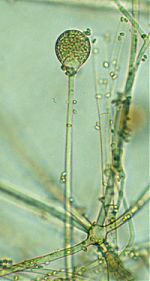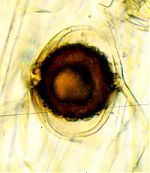Absidia
ABSIDIA van Tieghem, 1878 (Ann. Sci. Nat. Bot., Sér. 6, 4: 350); 19 spp. + 6 var. (Ellis and Hesseltine, 1965, 1966; Hesseltine and Ellis, 1961, 1964, 1966).
= Tieghemiella Berl. & de Toni, 1888 (In Saccardo, Syll. Fung. 7: 215).
= Proabsidia Vuillemin, 1903 (Bull. Soc. Mycol. France 19: 116).
Growth temperature optimal between 25 C and 34 C, range is 12 C to 37 C; mesophilic. Absidia is characterized by the formation of relatively small, apophysate sporangia with deliquescent walls, a single septum is formed in the subtending sporangiophore, and the production of stolons and rhizoids; the sporangiophore is never formed opposite the rhizoids (as in Rhizopus). Zygospores are formed on opposed, more or less equal suspensors adorned with several appendages.
Type species: A. repens
Species of Absidia:
A. anomala Hesseltine & J.J. Ellis, 1964 (Mycologia 56:578).
A. blakesleeana; = transferred to Lichtheimia.
A. californica J.J. Ellis & Hesseltine, 1965 (Mycologia 57:230).
A. coerulea Bainier, 1889 (Bull. Soc. Bot. France 36:184).
A. corymbifera; = transferred to Lichtheimia.
A. cuneospora Orr & Plunkett, 1959 (Mycologia 51:203).
A. cylindrospora var. cylindrospora Hagem, 1908 (Skrifter u.a. Vidensk.-Selsk. Christ. Math. Nat. Kl. No. 7, p. 45).
A. cylindrospora var. nigra Hesseltine & J.J. Ellis, 1964 (Mycologia 56:595).
A. cylindrospora var. rhizomorpha Hesseltine & J.J. Ellis, 1961 [1962] (Mycologia 53:409).
A. fassatiae Váňová, 1971 (Česká Mykol. 25:173).
A. fusca Linnemann, 1936 (Flora 130:201).
A. glauca Hagem, 1908 (Skrifter u.a. Vidensk.-Selsk. Christ. Math. Nat. Kl. No. 7, p. 43).
A. heterospora L. Yong, 1930 (Rev. Gén. Bot. 42:739).
A. hyalospora; = transferred to Lichtheimia.
A. idahoensis var. idahoensis Hesseltine, Mahoney & S.W. Peterson, 1990 (Mycologia 82:523).
A. idahoensis var. thermophila G.Q. Chen & R.Y. Zheng, 1998 (Mycotaxon 69:1974).
A. macrospora Váňová, 1968 (Česká Mykol. 22:296).
A. parricida; = transferred to Lentamyces.
A. padenii; the type species of Chlamydoabsidia.
A. pseudocylindrospora Hesseltine & J.J. Ellis, 1961 [1962] (Mycologia 53:406).
A. psychrophila Hesseltine & J.J. Ellis, 1964 (Mycologia 56:583).
A. ramosa; = transferred to Lichtheimia.
A. reflexa van Tieghem, 1878 (Ann. Sci. Nat., Bot., Sér. VI, 4:363).
A. repens van Tieghem, 1878 (Ann. Sci. Nat., Bot., Sér. VI, 4:363).
A. septata van Tieghem, 1878 (Ann. Sci. Nat., Bot., Sér. VI, 4:362).
A. scabra Coccini, 1899 (Accad. Sci. Bologna Mem. Ser. 5, 8:89).
A. spinosa var. azygospora Boedijn, 1958 [1959] (Sydowia 12:334).
A. spinosa var. biappendiculata Rall & Solheim, 1964 (Mycologia 56:99).
A. spinosa var. madecassensis M. Moreau, 1949 (Bull. Soc. Mycol. France 65:144).
A. spinosa var. spinosa Lendner, 1907 (Bull. Herb. Boiss., Sér. II, 7:250).
A. verticellata= the type species of Mycocladus.
A. zychae; = transferred to Lentamyces.
Absidia was divided into two subgenera (Absidia, Mycocladus) in 1964 by Hesseltine and Ellis. In the subgenus Absidia the zygospores are surrounded by suspensor appendages, whereas in the subgenus Mycocladus suspensor appendages are not produced. Mycocladus is being recognized as a genus with one species.
Proabsidia and Tieghemella are considered synonyms of Absidia (Berlèse and de Toni, 1888; Vuillemin, 1903a) whereas Lichtheimia, Protoabsidia, and Pseudoabsidia (Bainier, 1903; Vuillemin, 1903b; Naumov, 1935, 1939) are being treated as synonyms of Mycocladus. Absidia was described by van Tieghem (1878) and it has contained 20 to 25 spp. and 4 to 6 varieties (Kirk et al. 2001) that are found in soil, dung, and plant debris. Species now in Absidia were transferred to or originally described in five other genera [Tieghemiella (Berlèse and De Toni 1888), Mycocladus (Beauverie 1900), Lichtheimia (Vuillemin 1903b), Proabsidia (Vuillemin 1903a), and Pseudoabsidia (Bainier 1903)] before 1904. These genera have been differentiated on zygospore morphology, sporangiophore branching and orientation, and growth temperature.
One species (Absidia corymbifera), a species of Lichtheimia, is a human pathogen, but at least one other species of Absidia, A. coerulea has been isolated from infected animals (Ellis 1998; Voigt et al. 1999). Schipper (1990) accepted 17 species and 7 varieties in Absidia. The genus has been monographed by Ellis and Hesseltine (1965, 1966) and Hesseltine and Ellis (1961, 1964, 1966). New species were added by Váňová (1968, 1971). Chlamydoabsidia was treated as a synonym of Absidia by Váňová (1980). Three other treatments of Absidia have been published in the last 35 years (Mil’ko 1970; Váňová 1983; Schipper 1990). Two varieties of Absidia idahoensis have been described (Hesseltine et al. 1990; Chen and Zheng 1998) that have not been treated in the aforementioned monographs; A. idahoensis var. thermophila (Chen and Zheng, 1998) probably should be included in Lichtheimia because it grows above 37 C. Mi’ko (1970) treated two varieties of A. spinosa ([biappendiculata, madecassensis (Moreau, 1949; Rall and Solheim, 1964)] as synonyms of var. spinosa; A. spinosa var. azygospora was considered valid. Mycocladus and a new genus, Lentamyces, were recently described based on species previously included in Absidia (Hoffmann et al., 2007; Hoffmann and Voigt, 2008).
Bibliography
Bainier, G. 1903. Sur quelques espéces de Mucorinées nouvelles ou peu connes. Bull. Soc. Mycol. France 19:153-172.
Beauverie, J. 1900. Mycocladus verticillatus (gen. nov. sp. nov.). Annales de l’universitïé de Lyon, Séries 2, Sciences, Médicine 3:162-180.
Berlèse, A.N., and J.B. De Toni. 1888. Phycomyceteae, pp. 181-322. In. P.A. Saccardo’s Sylloge fungorum. R. Friedländer & Sohn, Berlin, Germany.
Chen, G.-q., and R.-y. Zheng. 1998. A new thermophilic variety of Absidia idahoensis from China. Mycotaxon 69:173-179.
Ellis, D.H. 1998. The Zygomycetes, pp. 247-277. In: L. Ajello, and R.J. Hay (Eds.). Medical mycology. Vol. 4. Topley & Wilson’s Microbiology and microbial infections. 9th Ed. Oxford University Press, Inc., New York
Ellis, J.J., and C.W. Hesseltine. 1965. The genus Absidia: globose-spored species. Mycologia 57: 222-235.
Ellis, J.J., and C.W. Hesseltine. 1966. Species of Absidia with ovoid sporangiospores. II. Sabouraudia 5: 59-77.
Hesseltine, C.W., and J. J. Ellis. 1961. Notes on Mucorales, especially Absidia. Mycologia 53: 406-426.
Hesseltine, C.W., and J. J. Ellis. 1964. The genus Absidia: Gongronella and cylindrical-spored species of Absidia. Mycologia 56: 568-601.
Hesseltine, C.W., and J. J. Ellis. 1966. Species of Absidia with ovoid sporangiospores. I. Mycologia 58:761-785.
Hesseltine, C.W., M.K. Mahoney, and S.W. Peterson. 1990. A new species of Absidia from an alkalai bee brood chamber. Mycologia 82:523-526.
Hoffmann K, Discher S, Voigt K. 2007. Revision of the genus Absidia (Mucorales, Zygomycetes) based on physiological, phylogenetic, and morphological characters; thermotolerant Absidia spp. form a coherent group, the Mycocladiaceae fam. nov., Mycological Research 111: 1169-1183.
Hoffman, K. and K. Voigt. 2009. Absidia parricida plays a dominant role in biotrophic fusion parasitism among mucoralean fungi (Zygomycetes): Lentamyces, a new genus for A. parricida and A. zychae. Plant Biology 10: 537-554.
Kirk, P.M., P.F. Cannon, J.C. David, and J.A. Stalpers (Eds.). Ainsworth & Bisby’s dictionary of the fungi. 9th Ed. CAB International, Wallingford, United Kingdom
Mil’ko, A.A. 1970. Genus Absidia van Tieghem (Mucorales). Nov. Syst. Plant. non Vascul. 7:121-138.
Moreau, M. 1949. Quelques Mucorinées de Madacascar. Bull. Soc. Mycol. France 65:142-151.
Naumov, N. A. 1935. Opredelitel Mukorovych ( Mucorales ). Second Rev. Ed. Bot. Inst. Acad. Sci. U. S. S. R., Moscow and Leningrad. 140 p. (In Russian).
Naumov, N. A. 1939. Clés des Mucorinées ( Mucorales ). Encycl. Mycol. Vol. 9. Paul Lechevalier, Editeur, Paris (1935 Russian ed. transl. by S. Buchet and I. Mouraviev.). 137 + xxxvi p.
Rall, G., and W.G. Solheim. 1064. A variety of Absidia isolated from Comandra pallida. Mycologia 56: 99-102.
Schipper, M.A.A. 1990. Notes on Mucorales—I. Observations on Absidia. Persoonia 14: 133-149.
Van Tieghem, P. 1878. Troisième mémoire sur les Mucorinées. Ann. Sci. Nat., Bot., Sér. VI, 4:312-399.
Váňová, M. 1968. Contribution to the taxonomy of the genus Absidia (Mucorales) I. Absidia macrospora sp. nov. Česká Mykol. 22:296-300.
Váňová, M. 1971. Contribution to the taxonomy of the genus Absidia (Mucorales) III. Absidia fassatiae spec. nov. Česká Mykol. 25:173-176.
Váňová, M. 1980. Rod Absidia van Tiegh. (Mucorales) v Ceskoslovensku [Genus Absidia van Tiegh. (Mucorales) in Czechslovakia]. I. Česká Mykol. 34: 113-122.
Váňová, M. 1983. Rod Absidia van Tiegh. (Mucorales) v Ceskoslovensku [Genus Absidia van Tiegh. (Mucorales) in Czechoslovakia]. II. Česká Mykol. 37: 151-171.
Voigt, K., E. Cigelnik, and K. O’Donnell. 1999. Phylogeny and PCR identification of clinically important Zygomycetes based on nuclear ribosomal-DNA sequence data. J. Clin. Microbiol. 37:3957-3964.
Vuillemin, P. 1903a. Importance taxonomique de l’appareil zygosporé des Mucorinées. Bull. Soc. Mycol. France 19:106-118.
Vuillemin, P. 1903b. Le genre Tieghemella et la série de Absidées. Bull. Soc. Mycol. France 19:119-127.
Updated Dec 01, 2012


